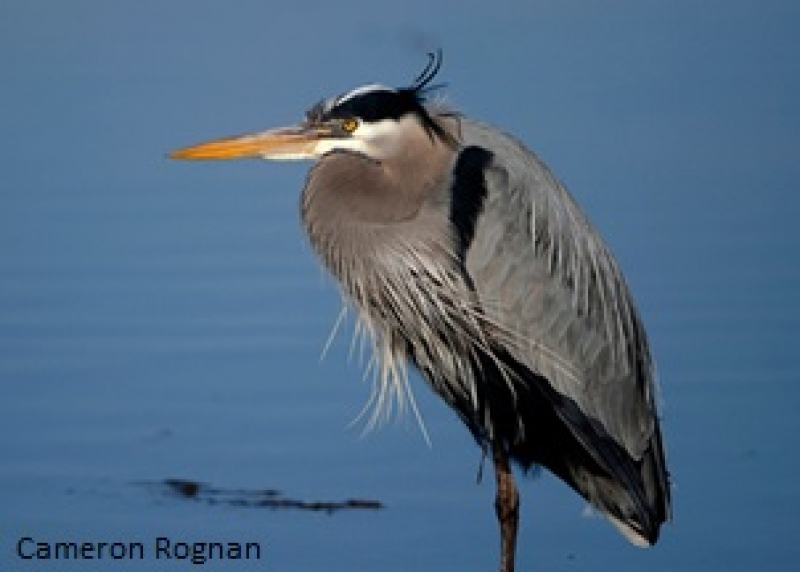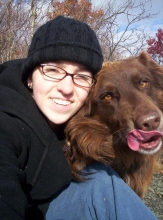
It's a Plane, It's Superman, It's a heron!
Because my name is Heron, I have had occasion to notice a lack of knowledge regarding this common North Country bird. When people meet me and I tell them my name is “Heron, like the bird” I am surprised by how many people haven’t heard of herons. Maybe I’m biased, but I think herons are one the most majestic birds on this earth. Every time I see one flying overhead or standing in the water on the shore of a lake or stream I become entranced by its movements. They can also be very awkward looking, with those long legs dangling as though they forgot to pull up the wheels after takeoff.
The most common heron in our area is the Great Blue  Heron. Standing anywhere from 3 to 4 ½ feet tall with a wingspan of 5 ½ to 6 ½ feet, these birds are impressive to see. Although nearly impossible to distinguish just by looking at one, the female is usually slightly smaller than the male. Their coloring a gray-blue with a black stripe over the eyes and when in flight you will see a darker coloring on the ends of the wings and lighter coloring around the shoulders. They have long necks with a yellow-orange beak and very long legs.
Heron. Standing anywhere from 3 to 4 ½ feet tall with a wingspan of 5 ½ to 6 ½ feet, these birds are impressive to see. Although nearly impossible to distinguish just by looking at one, the female is usually slightly smaller than the male. Their coloring a gray-blue with a black stripe over the eyes and when in flight you will see a darker coloring on the ends of the wings and lighter coloring around the shoulders. They have long necks with a yellow-orange beak and very long legs.
The habitat for these birds is typically swampy areas where flooding has killed the nearby trees. These dead trees are perfect for building their nests, which they will start to build as early as February in some places. A mating pair will share the responsibility of building the nest by collecting branches, twigs, and grass. These materials are woven together in the top of  a dead tree to form a messy looking basket-shaped platform. Sometimes a pair will build a series of nests in the same tree and reuse them each spring, making repairs as necessary. Bark, pine needles and even moss are sometimes added to the nest as well. From a distance these nest look like a pile of sticks was just dumped in the tree, but they can actually take up to two weeks to complete.
a dead tree to form a messy looking basket-shaped platform. Sometimes a pair will build a series of nests in the same tree and reuse them each spring, making repairs as necessary. Bark, pine needles and even moss are sometimes added to the nest as well. From a distance these nest look like a pile of sticks was just dumped in the tree, but they can actually take up to two weeks to complete.

Another reason that marshes or ponds are good habitat for herons is the abundant source of food. Herons eat fish, amphibians, insects, reptiles, small mammals and even some small birds. Due to the specialized vertebra in their necks, herons are able to curl their necks into an S shape which can quickly be stretched forward to grab unsuspecting prey. I have often seen one of these birds stalking its prey, walking slowing through the shallow water and waiting for just the right moment to strike.
Herons will nest and live together in what are known as ‘heron rookeries’. This means that multiple pairs will build nests in the same area. There are many of these rookeries around the North Country where you can go to see these flying giants for yourself. The Clarkson Trails in Potsdam have a nice rookery where a number of herons have built nests. If you look closely, you might find a heron rookery adjacent to any local river, lake, or wetland, but there are some established rookeries where you are almost guaranteed to see a few herons. Check out the Montezuma Wetlands Complex in Seneca county or the Great Swamp Conservancy on Oneida Lake to see what an established rookery looks like.


Several other species of heron can be seen in the North Country. The green heron can be seen during the summer, although it is not as common and if you are very lucky you might see a black-crowned nigh-heron. The little blue heron and yellow-crowned night-heron are two species which live slightly to the south of us and do not usually journey this far north. However, the American Bittern is a close relative of the heron and is does nest here during the spring and summer. Egrets are also related to herons, but you would have to travel to the coast to see one of those.
If you see a large shape in the sky with two legs dangling down and slow beating wings, you will know that a heron is passing. If it is flying low, then maybe you can follow it and see if there is a rookery nearby. You never know what might be living in the trees or the seemingly dead waters behind a beaver dam. If you are lucky, you might even get to see a few fledglings as they stretch their fuzzy heads towards the sky.


I agree that these are spectacular birds!